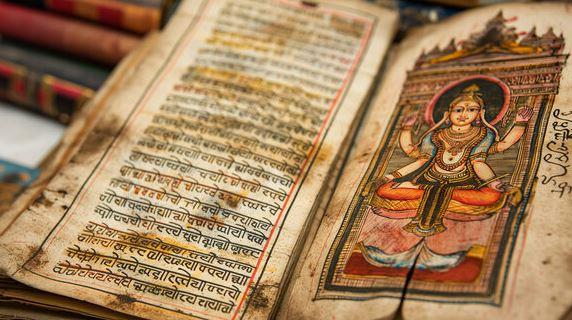
📜 The Vedas (Sanskrit: वेद)
The Vedas are the oldest sacred scriptures of Hinduism and among the oldest religious texts still in use today. "Veda" means knowledge in Sanskrit.
📚 The Four Main Vedas:
-
Rigveda – Hymns to the gods, cosmology, and philosophical questions
-
Yajurveda – Ritual instructions and ceremonial formulas
-
Samaveda – Chants and melodies for rituals
-
Atharvaveda – Spells, healing practices, and folk wisdom
🧘♂️ Themes in the Vedic Tradition
-
Nature worship (Agni the fire god, Indra the storm god, Varuna the cosmic order)
-
Cosmic order (Rta) → early form of Dharma
-
Mantras and sacred sounds
-
Sacrifice (Yajna) as a spiritual offering to maintain cosmic balance
-
Roots of Yoga and Meditation start here (esp. in later Vedic texts like the Upanishads)
🌀 Vedic Knowledge and Magic?
While the Vedas are spiritual and philosophical, they also contain esoteric elements:
-
Mantras seen as having magical power
-
Use of sound vibration to influence the world (think: early energy work)
-
Some Vedic hymns are invocations or spell-like chants
🌌 Core Philosophical Ideas from the Vedas
While the early Vedas (like the Rigveda) focus on hymns and rituals, the later Vedic texts, especially the Upanishads, get deeply philosophical. Here's a taste of their core teachings:
1. Brahman – The Absolute
Brahman is the infinite, unchanging, eternal reality behind everything.
-
It’s not a "god" in the Western sense, but the source of all existence, both immanent and transcendent.
-
It is pure being, consciousness, and bliss (Sat-Chit-Ananda).
2. Atman – The Self
Atman is the true self — beyond ego, thoughts, or identity.
-
The Upanishads boldly state: Atman is Brahman.
-
This means your deepest inner self is not separate from the Absolute.
🧠 You are not just in the universe — you are the universe, experiencing itself.
3. Maya – Illusion
The world we see is real, but it's not the ultimate reality.
-
Maya is the veil that makes the One appear as many.
-
It's the illusion of separation, multiplicity, and permanence.
-
Think: a dream feels real while you're dreaming.
4. Karma & Dharma
-
Karma: the law of cause and effect — your actions shape your experience.
-
Dharma: your cosmic duty or truth — living in alignment with the natural order.
Together, they form the engine of samsara (the cycle of birth and rebirth).
5. Moksha – Liberation
The ultimate goal is moksha — freedom from the cycle of rebirth.
-
Moksha is attained through self-realization, by knowing you are not the body or mind, but the eternal Self.
-
It’s not an escape, but a waking up.
🧘 How This Ties Into Spiritual Practice
The Vedic teachings gave rise to Yoga, Vedanta, and Tantra, all of which explore:
-
Meditation to quiet the mind
-
Self-inquiry (Who am I?)
-
Ethical living (ahimsa, truthfulness, non-attachment)
-
Direct realization over dogma

